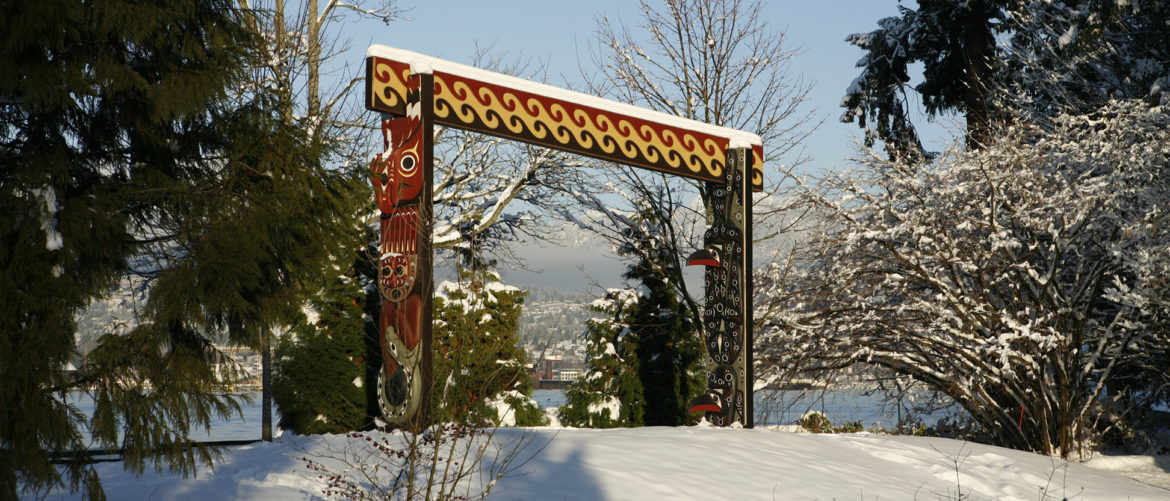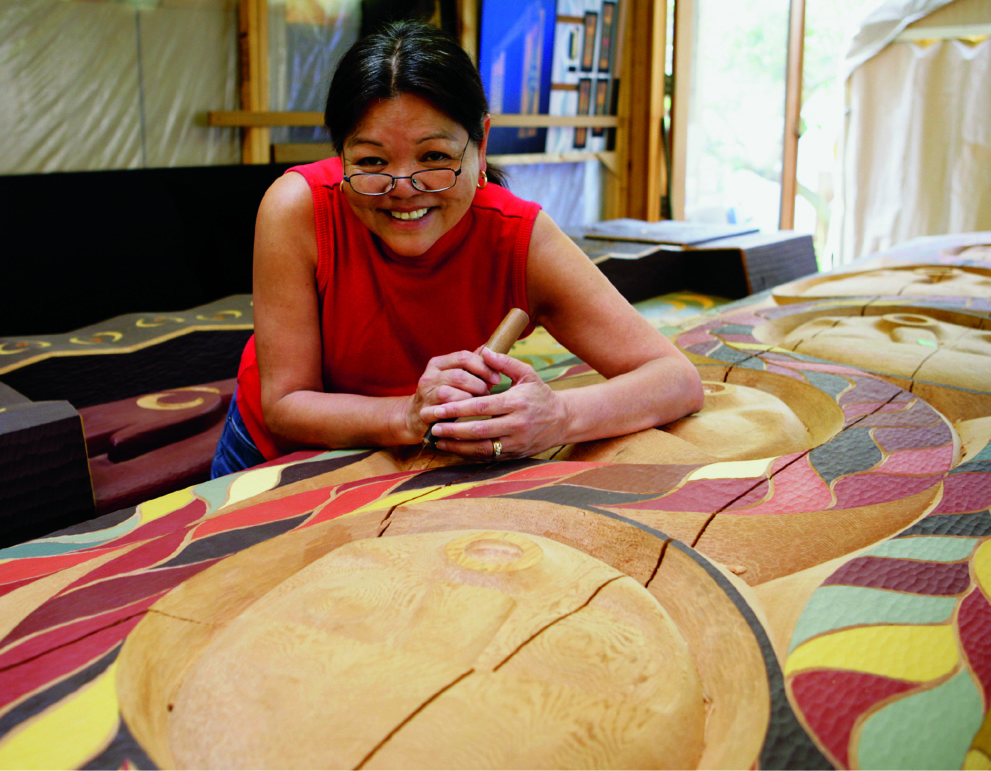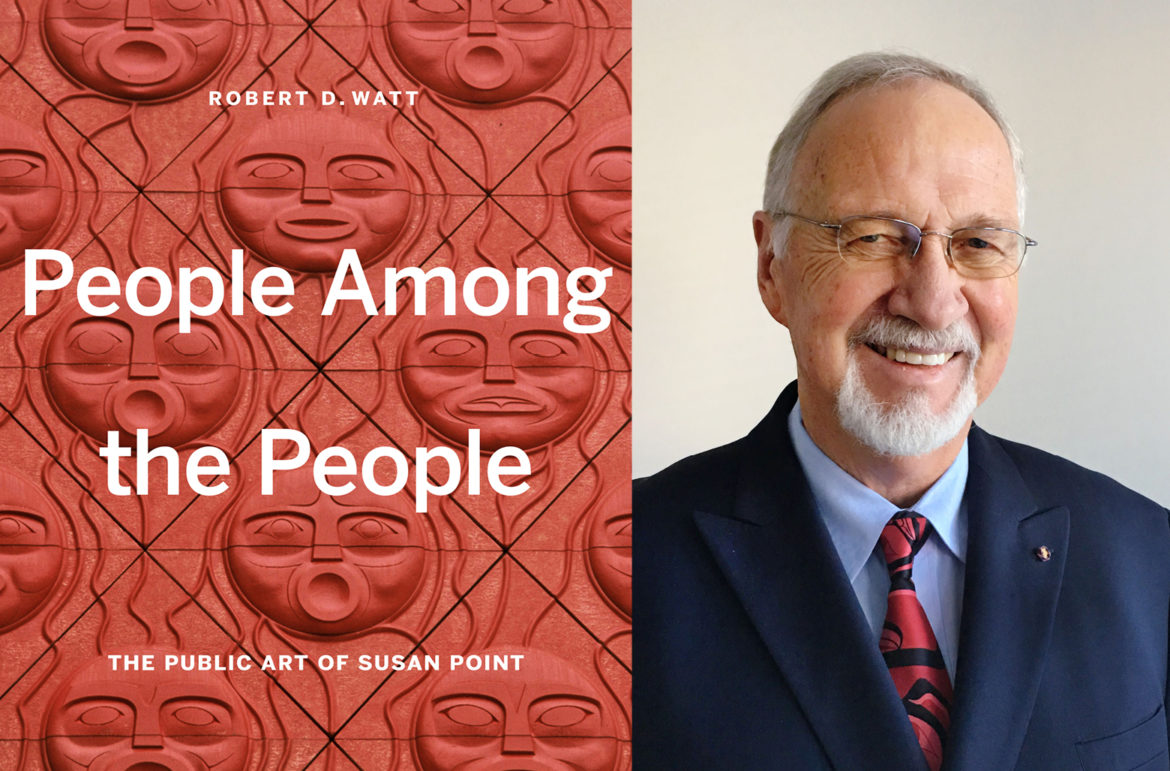Susan Point’s unique artworks have been credited with almost single-handedly reviving the traditional Coast Salish art style. Once nearly lost to the effects of colonization, the crescents, wedges, and human and animal forms characteristic of traditional Coast Salish art can now be seen around the world–reinvigorated with modern materials and techniques–in her serigraphs and public art installations, as well as in the works of a new generation of artists that she’s inspired.
People Among the People beautifully displays the breadth and depth of her public art, from cast bronze faces in Whistler to massive carved cedar portals in Stanley Park to moulded polymer murals in Seattle.
Through interviews and archival access, Robert D. Watt gathers the story of each piece, often in Point’s own words, to illustrate the vital role she has played in revealing and re-establishing the “Salish footprint” in the Pacific Northwest.
– from Figure 1 Publishing
You’ve known Susan Point (and been an admirer of her art) since 1981. How and when did the idea for the project that would become People Among the People come about?
The idea arose at a dinner at Simon Fraser University in 2008. We were seated next to one another at a dinner table and I asked Susan if anyone had ever proposed to work with her to write a book which would be focussed on her work. She invited me to discuss the idea at her studio and the project grew from there. Initially, the concept was to select some of her favourite work and centre descriptions around her own thoughts about why works were important, how media had been chosen, and so forth. After several years of interviewing, we settled on the idea of dealing only with her public work, in part because it was challenging for a museum or gallery to deal with work permanently sited in an outdoor or other public setting.

The book is organized geographically, not chronologically, which you write was the advice of your editor. What effect did this reordering have on the book?
As you would expect, it had a significant effect, not so much on the writing, but more on deciding, together with the editor, what was the optimum geographic arrangement. One reviewer has lamented that the change makes it more challenging to understand the evolution of Dr. Point’s art from earliest to latest, but most readers seem to enjoy working with familiar to less familiar neighbourhoods first in Metro Vancouver and then farther away.
The importance of re-establishing a Coast Salish “footprint” in the Pacific Northwest is central to Point’s work, and your descriptions of her art often highlights the distinctive Coast Salish elements, like crescents, wedges, and V-cuts, that she uses. If possible, could you give readers a crash course in the essential elements of traditional Coast Salish art, that they might more easily recognize them when viewing Point’s public works?
You have listed the essential elements of traditional Coast Salish art; wedges, crescents (often used around a circle or point), and V-cuts. A very good place to admire how Susan used these from the beginning of her work as an artist are the arches in St. Paul’s church on Squamish lands in North Vancouver. Together these are used to fill areas and to outline or emphasize limbs and various body parts in humans or other creatures. Very broadly speaking, Salish designs tend to be more naturalistic and less abstracted than more northern styles such as Kwakwaka’wakw, Haida, Tsimshian and Nisga’a. I caution that I am not an expert in this area.
Those who want to delve further might try to get hold of a copy of Dr. Michael Kew’s pioneering studies of Coast Salish culture and art. Ideally you could [talk to] Susan Point herself, she is so deeply knowledgeable and versed in using these elements. That said, they are a point of departure for her, and her works are very much her own, moving into contemporary creations of her own, using these elements decided from the study of historic examples.

Many methods and mediums are represented in Point’s public artworks, including wood, glass, iron, granite, wool… was there a piece or process you discovered in your research that surprised you, or that you feel exemplifies her ability to adapt and evolve as an artist?
Her work in glass was a complete revelation to me, not just antique art glass (used in the great Tree of Life window in Christ Church Cathedral at Georgia and Burrard) but pieces that are freestanding in slab glass, fused glass, and blown glass which is then sand etched with her designs.
Vancouverites are lucky to have access to so many of Point’s pieces, it’s hard to know where to start! Is there a piece or pieces in particular that you’d direct new Vancouverites (or new fans of Susan Point) to?
To admire her skill as a carver, and creator of comprehensive designs, without question a must-see commission is the assembly of three portals: People Amongst the People (2008), at Brockton Point in Stanley Park, and the house posts on the path west of the Museum of Anthropology at UBC. For a daring idea, the cast concrete runnels on the piers on the north side of the Olympic Skating oval in Richmond, and then a visit to the polychromed wood templates from which the casts were made, on display in the atrium of the Technology and Applied Sciences building at SFU (Blue Herons, 2008). For a dramatically unexpected visual treat in coloured die cut aluminum, see Woven Together (2016), at the Johnson Street parkade in Victoria.
Susan Point is a descendant of the Musqueam and a leader of the resurgence of Coast Salish art. She is an Officer of the Order of Canada, and has been awarded a Queen Elizabeth II Diamond Jubilee Medal, an Indspire Achievement Award, and a lifetime appointment to the Royal Canadian Academy of arts, among many other honours. Point has honorary doctorates from the University of Victoria, Simon Fraser University, the University of British Columbia, and Emily Carr University of Art and Design. In 2018 she was awarded the Audain Prize for lifetime achievement in the Arts.
Robert D. Watt studied at UBC and Carleton University before working in the Public Archives of Canada, Capilano College, and as the City Archivist for the City of Vancouver. In 1973 he joined the Centennial Museum (now known as the Museum of Vancouver) as the Curator of History, and in 1980 was appointed Director of the Museum. In 1988 Watt was appointed the first Chief Herald of Canada, and upon his retirement in 2007 was appointed Rideau Hall of Emeritus. His honours and awards include the 125th Canadian Confederation Medal, the Queen’s Golden and Diamond Jubilee medals, and investiture into the Royal Victorian Order.
People Among the People is the winner of the 2019 City of Vancouver Book Award
Find People Among the People here.

